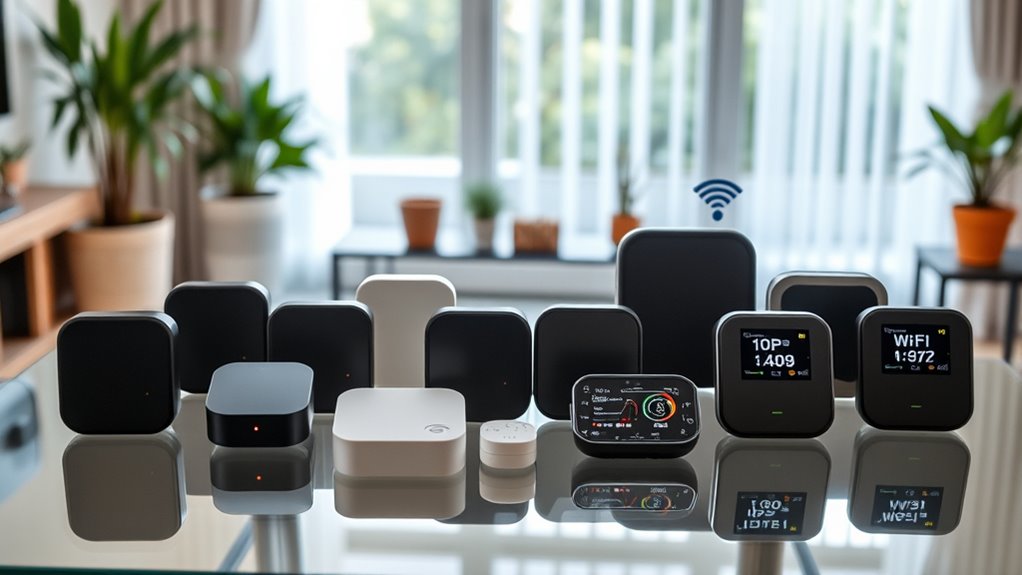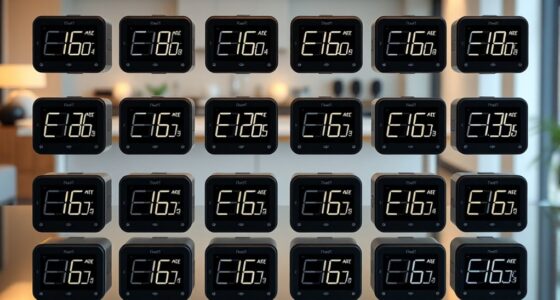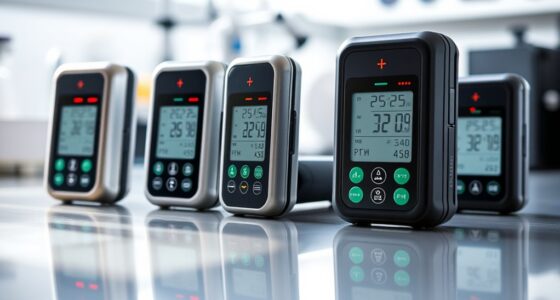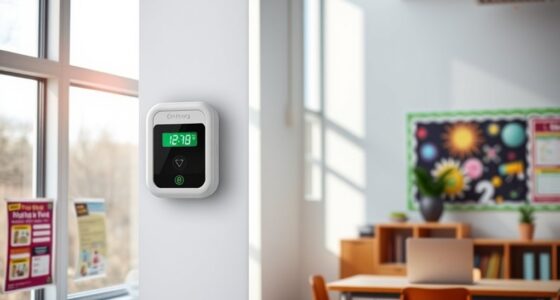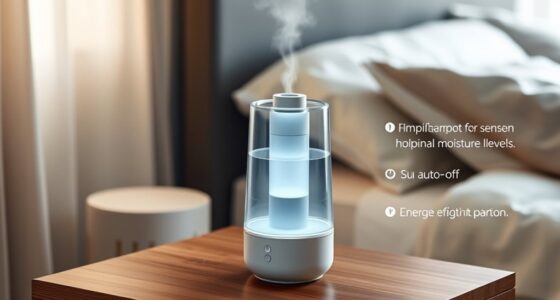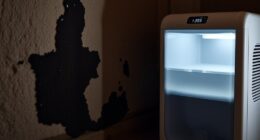I’ve found the top 14 VOC sensors with Wi-Fi that make indoor air quality monitoring smarter and more convenient. These devices track parameters like VOCs, PM, CO2, temperature, and humidity, often with real-time alerts and remote data access. They’re easy to set up and integrate with smart home systems like Alexa or Google Home. If you’re curious about which models stand out and how they can improve your indoor environment, keep exploring.
Key Takeaways
- These sensors monitor VOCs, PM2.5, CO2, humidity, and temperature for comprehensive indoor air quality control.
- They connect via WiFi, compatible with smart home platforms like Alexa and Google Home.
- Features include real-time data, customizable alerts, data storage, and scene automation capabilities.
- Setup is quick and straightforward, often supporting remote monitoring and integration with other smart devices.
- They are suitable for homeowners, property managers, and professionals seeking detailed, long-term air quality insights.
WiFi Air Quality Monitor with IoT Controller and Data Logger

If you’re looking for a reliable air quality monitor with Wi-Fi connectivity, this device is an excellent choice. It detects six key parameters: PM2.5, PM1.0, TVOC, CO2, temperature, and humidity, using advanced sensors for accurate readings. With both manual and automatic calibration modes, it maintains precision over time. The device connects seamlessly to Wi-Fi via the Tuya App, allowing remote monitoring, alerts, and data viewing from anywhere. Plus, it functions as an IoT controller, enabling smart scene creation to automate appliances like fans and purifiers. Its RS485 port and relays also support professional data export and direct device control.
Best For: homeowners, property managers, and professionals seeking accurate, remote monitoring and control of indoor air quality with IoT integration.
Pros:
- Provides comprehensive air quality data for six key parameters with high precision sensors.
- Supports remote monitoring, alerts, and smart scene creation via the Tuya App for automation and convenience.
- Includes professional-grade features like RS485 data export and relay control for advanced applications.
Cons:
- Requires Wi-Fi connection and app setup, which may be complex for some users.
- May be more expensive compared to basic air quality monitors due to advanced features.
- Relays and professional ports might be unnecessary for casual or home use, limiting simplicity for non-technical users.
Temtop M10+ Indoor Air Quality Monitor with App Connectivity

The Temtop M10+ Indoor Air Quality Monitor stands out for its all-encompassing tracking of CO2, PM2.5, VOCs, temperature, and humidity, making it ideal for users who want a detailed view of their indoor environment. It uses advanced sensors for accurate readings and adjusts monitoring frequency based on air quality changes. The device features a Bluetooth connection to the Temtop app, enabling data analysis, historical tracking, and calibration. With an e-ink display and up to 60 days of battery life, it offers reliable, long-term monitoring. Although it lacks Wi-Fi and has some app limitations, users find it effective for detecting ventilation issues and maintaining overall air quality.
Best For: individuals seeking comprehensive, long-term indoor air quality monitoring with reliable sensors and detailed data analysis, even without Wi-Fi connectivity.
Pros:
- Accurate sensors for CO2, PM2.5, VOCs, temperature, and humidity, providing detailed environmental data
- Up to 60 days of battery life with energy-efficient design and clear e-ink display for easy readability
- Automatic adjustment of monitoring frequency based on air quality changes for optimal sensitivity
Cons:
- Limited app functionality with Bluetooth only, lacking Wi-Fi for remote monitoring
- App issues such as Bluetooth connection problems and limited data visualization options
- Higher price point compared to basic monitors, with limited alarm customization and features
Amazon Smart Air Quality Monitor – Know your air, Works with Alexa
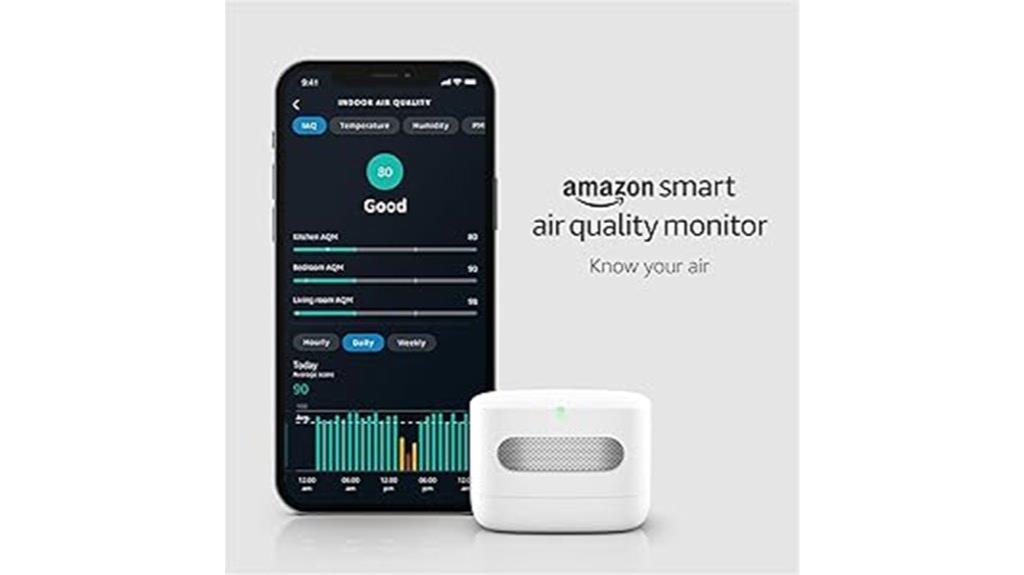
The Amazon Smart Air Quality Monitor stands out for anyone looking to keep a close eye on indoor air health with seamless Alexa integration. It tracks five key factors: PM 2.5, VOCs, CO, humidity, and temperature, providing real-time insights via a color-coded LED and an easy-to-understand air quality score in the Alexa app. It sends notifications or Echo announcements when air quality drops, so you’re always informed. Plus, it can trigger routines to automatically control compatible devices like purifiers and fans. With simple setup and integration into the Alexa ecosystem, it makes monitoring and improving your indoor environment effortless and accessible.
Best For: individuals or families seeking an easy-to-use device to monitor and improve indoor air quality with seamless Alexa integration.
Pros:
- Tracks five key indoor air factors including PM 2.5, VOCs, CO, humidity, and temperature for comprehensive monitoring
- Sends real-time notifications and Echo announcements to keep users informed of air quality issues
- Enables automation of compatible devices like purifiers and fans through Alexa routines for effortless air quality management
Cons:
- Requires an Alexa-enabled device or app for full functionality
- May need additional compatible devices (e.g., air purifiers) to automate improvements
- Limited to indoor air quality monitoring; does not measure outdoor air conditions
GoveeLife Smart Air Quality Monitor
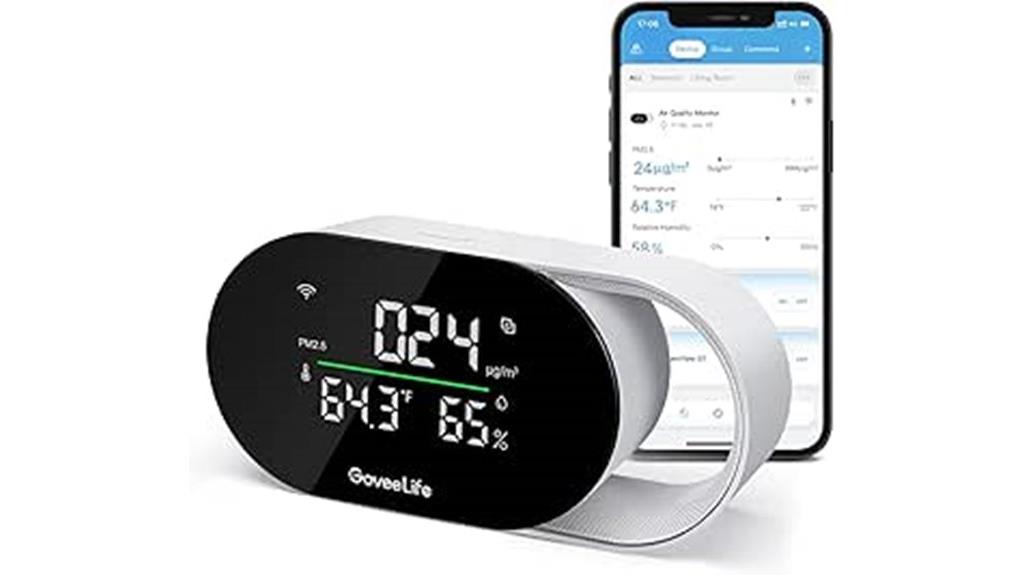
For those seeking an affordable, easy-to-use air quality monitor with smart home integration, the GoveeLife Smart Air Quality Monitor stands out. Its sleek, compact design fits seamlessly into any space, offering real-time data on PM2.5, temperature, and humidity. Powered via Type-C, it requires no batteries, making setup simple. With Bluetooth and Wi-Fi connectivity, I can monitor air quality remotely and automate compatible devices like air purifiers or humidifiers. Though it doesn’t measure VOCs or CO2, it provides quick, accurate readings and supports data storage for two years. Overall, it’s an effective, budget-friendly option for smarter indoor air management.
Best For: individuals seeking an affordable, easy-to-use air quality monitor with smart home integration for real-time indoor air assessment.
Pros:
- Compact, modern design that easily blends into any space
- Quick, accurate readings of PM2.5, temperature, and humidity with data refresh every 2 seconds
- Supports remote monitoring and automation via Bluetooth and Wi-Fi, compatible with GoveeHome appliances
Cons:
- Does not measure VOCs, CO2, or other specific pollutants, limiting comprehensive air quality analysis
- Occasional connectivity issues, especially on 2.4 GHz Wi-Fi networks
- Lacks built-in sensors for gases like CO or combustible substances
G1 WiFi Gateway – Temperature & Humidity Sensor Gateway
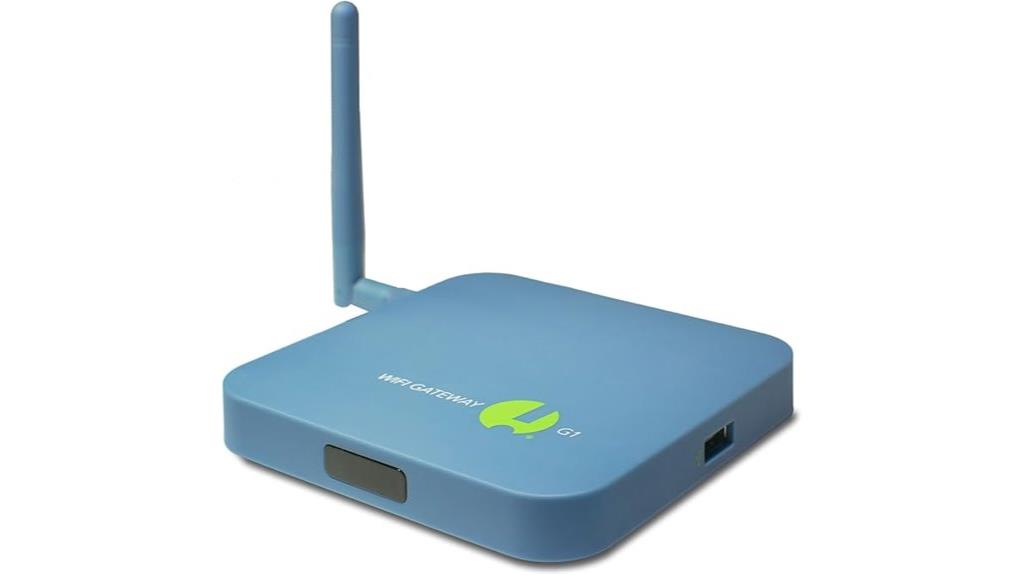
If you need reliable remote monitoring for temperature and humidity, the SensorPush G1 WiFi Gateway is an excellent choice because it provides real-time data access and unlimited cloud storage at no extra cost. Setting it up is quick—just plug into WiFi, pair via Bluetooth, and add sensors within minutes. It offers instant alerts for limit violations and keeps detailed historical records accessible from your mobile device or computer. Its intuitive app and cloud service make remote monitoring straightforward, whether for a greenhouse, wine cellar, or storage unit. Overall, it’s a dependable, easy-to-use solution that keeps you informed and protected around the clock.
Best For: individuals or businesses needing reliable, real-time remote monitoring of temperature and humidity for environments like greenhouses, wine cellars, storage units, or outdoor spaces.
Pros:
- Easy setup with quick WiFi connection, Bluetooth pairing, and sensor addition within minutes
- Unlimited cloud storage at no extra cost for historical data and real-time access
- Accurate, real-time alerts for temperature and humidity limit violations, with customizable notifications and calibration options
Cons:
- Higher upfront cost for the gateway and sensors compared to basic monitoring devices
- Dependence on WiFi and Bluetooth connectivity, which may be affected by range or network issues
- Limited to sensors and gateway manufactured by SensorPush, potentially reducing compatibility with third-party devices
HT.w Smart Temperature & Humidity Sensor with App Monitoring
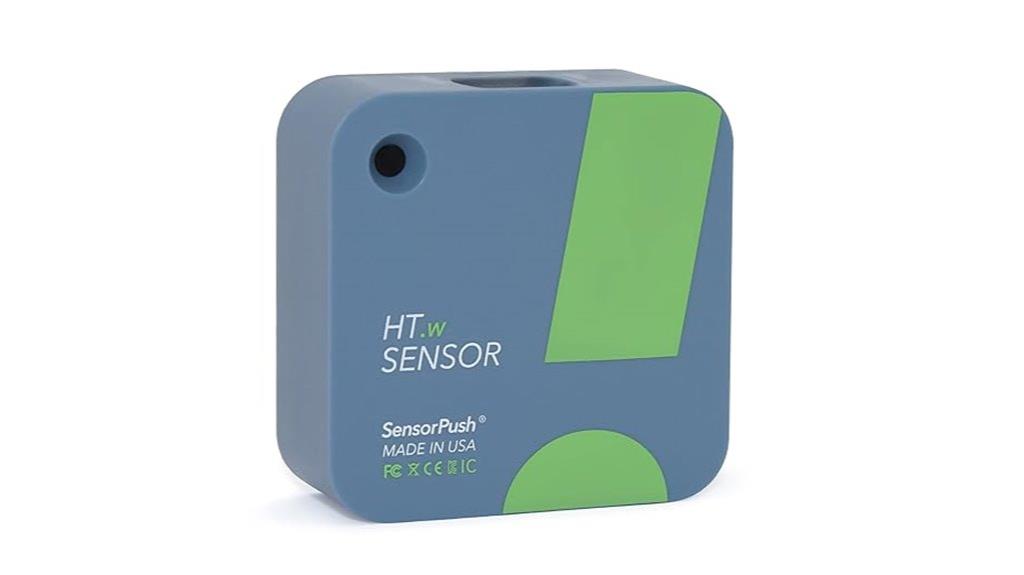
Anyone seeking reliable, real-time monitoring of temperature and humidity in diverse environments will appreciate the HT.w Smart Sensor’s quick setup and long-lasting battery life. It takes just seconds to configure, with hardware built for durability and up to 2 years of battery life under normal use. The sensor offers excellent Bluetooth range (up to 100 meters line of sight), ensuring seamless data updates through its app. It continuously records temperature, humidity, dew point, and VPD, with 45 days of onboard data storage and unlimited in-app storage. Adding a G1 WiFi Gateway enables remote access and cloud storage, making it versatile for indoor, outdoor, and specialized environments.
Best For: anyone needing reliable, real-time temperature and humidity monitoring across various indoor and outdoor environments with easy setup and long battery life.
Pros:
- Quick and simple setup process takes only seconds
- Long-lasting battery life of up to 2 years under normal use
- Versatile application suitable for indoor, outdoor, and specialized environments
Cons:
- Requires optional G1 WiFi Gateway for remote access and cloud storage
- Bluetooth range may be limited by obstacles despite up to 100 meters line of sight
- Limited onboard storage (45 days) unless additional cloud service is used
Smart Temperature Humidity Sensor with WiFi and App Alerts
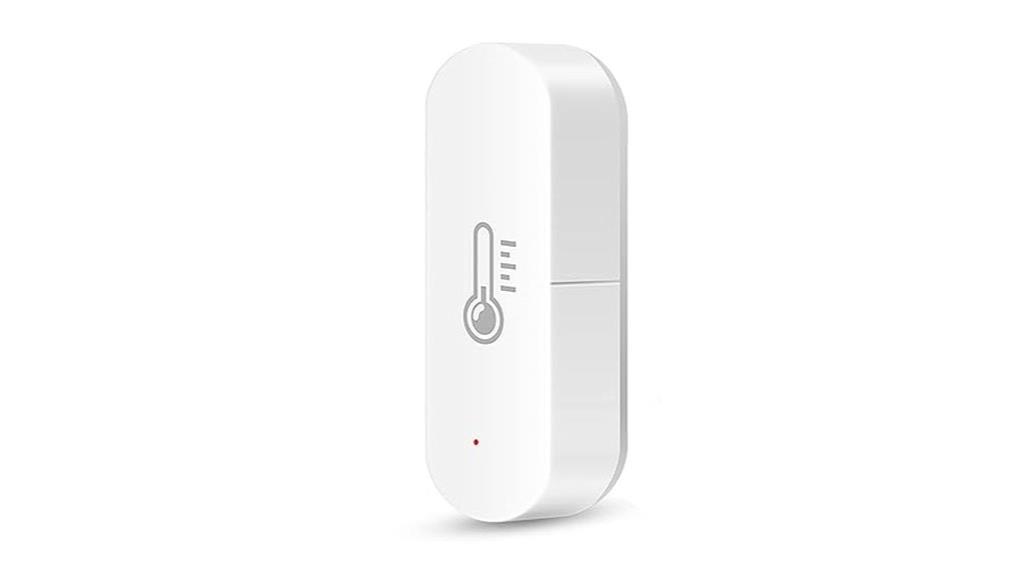
The Smart Temperature Humidity Sensor with WiFi and App Alerts is an ideal choice for those seeking precise, real-time monitoring of indoor conditions without the hassle of extra hubs or complicated setup. It works seamlessly with Alexa, Google Home, Smart Life, and Tuya Smart App, connecting over 2.4GHz WiFi. Its compact design suits various spaces like offices, greenhouses, or pet enclosures. You can easily monitor temperature and humidity remotely, with data updates every 30 minutes and interactive graphs for trend analysis. Plus, it supports scene automation, allowing you to link with devices like ACs or humidifiers for smarter, energy-efficient control.
Best For: individuals seeking easy-to-install, remote monitoring of indoor temperature and humidity without the need for additional hubs or complex setup.
Pros:
- Compatible with popular smart home platforms like Alexa, Google Home, and Tuya Smart App for seamless integration.
- Real-time data updates with interactive graphs enable effective trend analysis.
- Supports scene automation with devices like ACs and humidifiers to enhance energy efficiency and comfort.
Cons:
- Battery life may be limited depending on the chosen update interval, requiring periodic replacements.
- Requires a stable 2.4GHz WiFi connection for optimal performance; not compatible with 5GHz networks.
- Limited to indoor use; not suitable for outdoor or extreme environments.
Smart WiFi Temperature Humidity Monitor with APP Alerts

The Smart WiFi Temperature Humidity Monitor with APP Alerts stands out for its ability to provide real-time environmental updates directly to your smartphone, making it ideal for homeowners who want constant oversight of indoor conditions. It connects via 2.4 GHz WiFi and accurately measures temperature and humidity, supporting both ℃ and ℉ units. The device features a clear LCD display showing current time, date, temperature, and humidity, with historical data accessible through the app. Powered via USB, it eliminates battery worries but requires continuous power. Its compact size fits various spaces, and automation features let you set alerts or trigger smart devices based on environmental thresholds.
Best For: homeowners and indoor environment enthusiasts seeking real-time WiFi-connected temperature and humidity monitoring with app alerts and automation capabilities.
Pros:
- Provides accurate temperature and humidity readings with real-time updates via WiFi
- Supports automation and scene creation for smart device control based on environmental thresholds
- Eliminates the need for batteries, reducing maintenance and replacement costs
Cons:
- Limited voice support for humidity data, with some devices only providing temperature info through Alexa
- Requires constant USB power; unplugging resets the device and disrupts monitoring
- No backlit display, making it difficult to read in low-light conditions
Proteus AMBIO WiFi Temperature and Humidity Sensor

If you need a reliable, easy-to-use WiFi sensor for monitoring temperature and humidity in your home or office, Proteus AMBIO stands out with its no-monthly-fee cloud connectivity. It plugs directly into a wall outlet and includes a 3-inch sensor extension for better accuracy. The device offers real-time data via a user-friendly web interface, customizable alerts, and a programmable buzzer that can be muted. Setup is quick—just connect to WiFi, create a free account, and start monitoring. Its compact size and support for multiple sensors make it ideal for critical environments like server rooms or smart homes. Customer feedback highlights its accuracy and ease of use.
Best For: homeowners, office managers, and smart home enthusiasts seeking reliable, real-time WiFi temperature and humidity monitoring without ongoing fees.
Pros:
- Easy to set up with quick WiFi connection and cloud account creation
- Accurate, real-time temperature and humidity readings with customizable alerts
- Supports multiple sensors under one account, ideal for various environments
Cons:
- No dedicated mobile app; relies on web interface for monitoring
- Humidity readings may occasionally become inaccurate over time, requiring troubleshooting
- Setup can be more complex if WiFi has MAC filtering or restricted networks
4-Pack WiFi Temperature Humidity Sensor with App Alerts
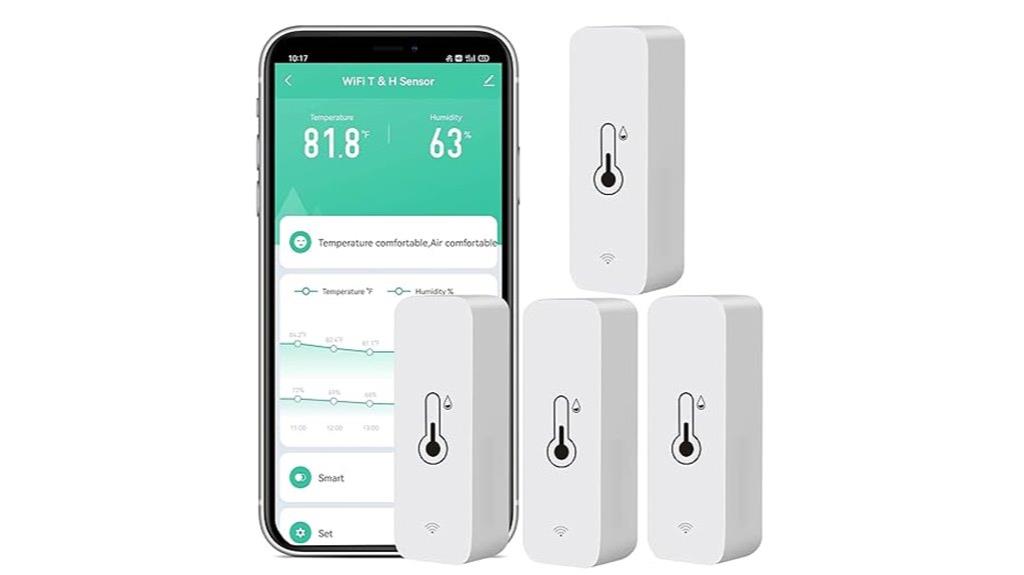
For anyone seeking a compact and easy-to-use solution for monitoring indoor environments, the 4-pack WiFi Temperature Humidity Sensors with App Alerts stand out. These sensors connect via 2.4 GHz WiFi, support app notifications, display real-time data, and generate historical graphs. They’re compatible with Alexa, Google Assistant, and Tuya Smart, allowing voice control and scene automation. Their small size makes them perfect for tight spaces like reptile vivariums or potted plants. Powered by two AAA batteries, they offer long standby times, with alerts for low battery. Setup is straightforward, and placement options include stickers or screws, making environmental monitoring simple and accessible.
Best For: those seeking an affordable, easy-to-install solution for basic indoor and outdoor environment monitoring with app alerts and voice control.
Pros:
- Compact design suitable for small spaces and discreet placement
- Supports app notifications, historical data, and graphing for environmental tracking
- Compatible with Alexa, Google Assistant, and Tuya Smart for voice control and scene automation
Cons:
- Limited automation capabilities; cannot integrate with IFTTT or Hubitat for advanced routines
- Battery life can be short, especially outdoors or in cold temperatures, requiring frequent replacements
- Connectivity issues and occasional device failures reported by some users
X-Sense Wi-Fi Hygrometer with Base Station and App Control

Anyone seeking reliable remote monitoring of indoor humidity and temperature will appreciate the X-Sense Wi-Fi Hygrometer with its SBS50 base station and app control. It supports real-time data access via the X-Sense Home Security App, compatible exclusively with 2.4 GHz Wi-Fi networks. The device offers precise temperature (±0.36°F/±0.2°C) and humidity (±2% RH) measurements, with a range up to 1,700 feet. It can support up to 10 sensors, making it ideal for monitoring multiple spaces indoors or outdoors. Notifications alert you when thresholds are exceeded, and you can view, store, or export data easily, ensuring you’re always informed about your environment.
Best For: individuals and homeowners seeking precise, remote indoor humidity and temperature monitoring across multiple spaces using a reliable Wi-Fi-connected device.
Pros:
- Supports real-time remote monitoring with high accuracy (±0.36°F/±0.2°C for temperature and ±2% RH for humidity).
- Compatible with up to 10 sensors, ideal for large or multi-level environments.
- Offers app notifications and data export options, keeping users informed and enabling easy data management.
Cons:
- Only supports 2.4 GHz Wi-Fi networks, making it incompatible with 5.0 GHz networks.
- Requires the SBS50 base station for operation, adding to the initial setup cost.
- Open-air transmission range may be limited by physical obstructions despite its maximum of 1,700 feet.
Air Quality Monitor Indoor (8-in-1)
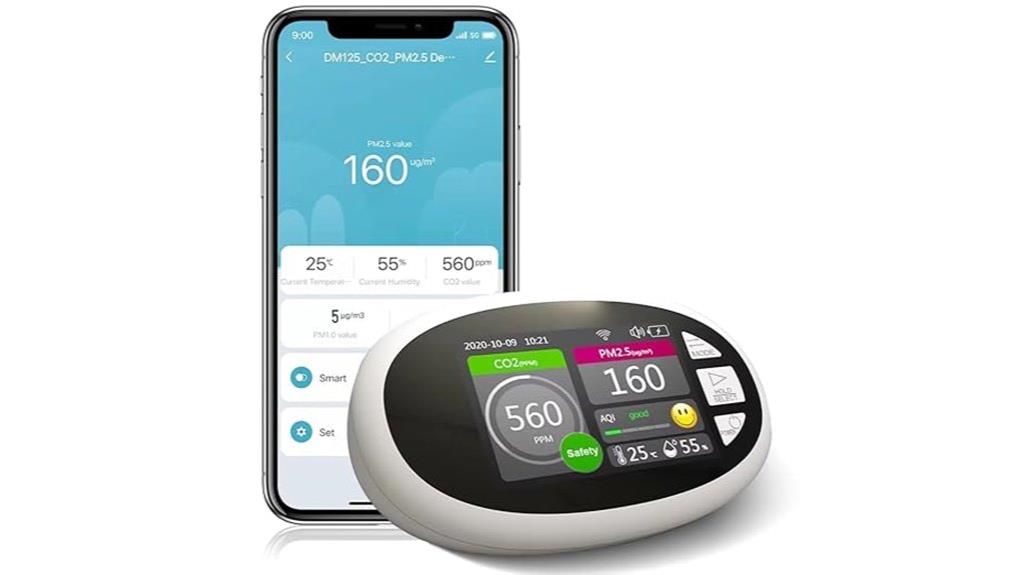
The Air Quality Monitor Indoor (8-in-1) stands out for those seeking a thorough and easy-to-use device that provides real-time environmental data. It measures eight key indicators—CO2, PM2.5, PM1.0, PM10, AQI, temperature, humidity, and time—giving a complete picture of indoor air quality. Its large LCD screen displays accurate, real-time readings, thanks to dual-chip technology. The compact, portable design makes it simple to move between rooms, and setup takes just about 30 seconds. With built-in WiFi, you can monitor your environment remotely via a smartphone app, making it convenient to track and improve indoor air conditions effortlessly.
Best For: individuals or families seeking a comprehensive, easy-to-use indoor air quality monitor to ensure a healthy and comfortable environment.
Pros:
- Measures 8 key environmental indicators for a complete air quality overview
- Large LCD screen displays real-time, accurate data with dual-chip technology
- Portable, lightweight design with quick setup and wireless remote monitoring via smartphone app
Cons:
- May require WiFi connection for remote features, which could be an issue in areas with poor internet
- Limited to indoor use; not suitable for outdoor air quality monitoring
- Small buttons and menus might be less intuitive for some users unfamiliar with digital devices
Asani Indoor Air Quality Monitor, 9-in-1 Portable Device for Home & Office

The Asani Indoor Air Quality Monitor stands out as the ideal choice for those seeking a portable, easy-to-use device that provides real-time detection of multiple air pollutants. It’s a 9-in-1 device that measures CO2, VOCs, formaldehyde, PM2.5, PM10, humidity, temperature, and AQI, making it versatile for home, office, or outdoor use. Its compact design and clear display eliminate the need for Wi-Fi or app controls, simplifying operation. With a 3000 mAh battery that lasts up to 11 hours and auto-shutdown for durability, it’s perfect for maintaining healthier indoor environments wherever you go. Proper calibration guarantees consistent, accurate readings over time.
Best For: individuals seeking a portable, all-in-one air quality monitor for maintaining healthy environments at home, in the office, or on the go.
Pros:
- Measures 8 major air pollutants including CO2, VOCs, formaldehyde, and particulate matter for comprehensive air quality assessment.
- No Wi-Fi or app required thanks to its user-friendly, clear display, enabling straightforward operation.
- Long-lasting with up to 11 hours of battery life and auto-shutdown feature for enhanced durability.
Cons:
- Requires initial calibration and a 10-minute air circulation period for accurate readings.
- Limited to battery-powered use with no option for continuous power connection.
- May be less suitable for real-time monitoring via remote control or app integration.
Smart Air Quality Monitor, WiFi Indoor Air Quality Meter
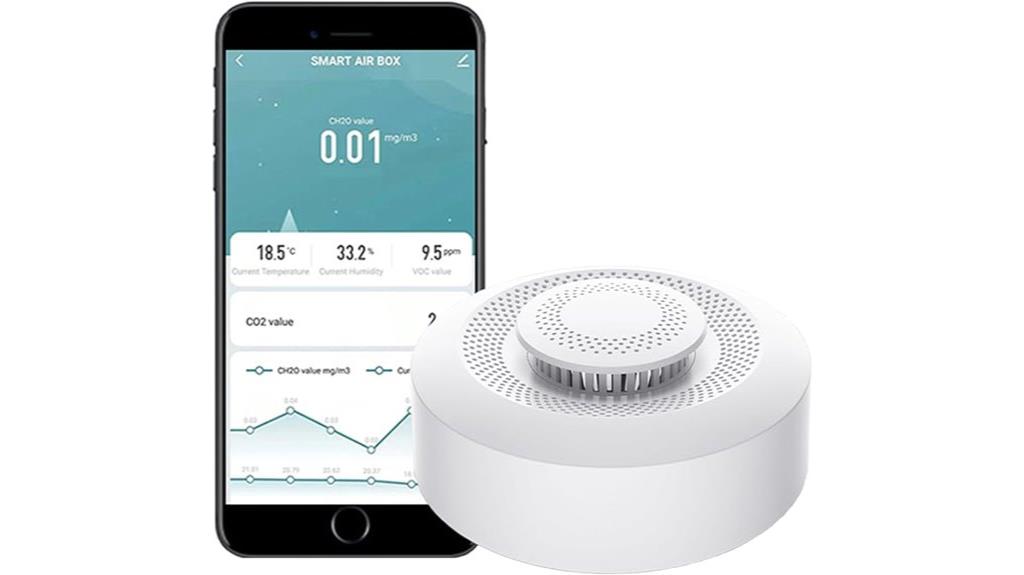
If you’re looking for a compact device that provides real-time insights into your indoor air quality, the Smart Air Quality Monitor is an excellent choice. It detects CO2, formaldehyde, VOCs, temperature, and humidity, all in a sleek 90x90x35mm design. Powered via USB, it connects through Wi-Fi (2.4GHz only) and pairs with the Tuya Smart or Smart Life app for remote monitoring, data visualization, and automation. You can link it to other smart devices like air purifiers or fans for automatic adjustments. While some users note calibration and accuracy issues, overall, it offers a convenient, modern way to keep an eye on your indoor environment.
Best For: those seeking a compact, Wi-Fi-enabled indoor air quality monitor for real-time environmental insights and smart home automation.
Pros:
- Compact, modern design that fits seamlessly into various indoor spaces
- Easy setup with app integration for remote monitoring and automation
- Supports linking with other smart devices for automatic environmental adjustments
Cons:
- Some users report calibration and accuracy issues with CO2 readings
- Limited compatibility to 2.4GHz Wi-Fi, not supporting 5G networks
- Concerns about device durability, lightweight construction, and potential app glitches
Factors to Consider When Choosing a VOC Sensor With Wi‑Fi Connectivity
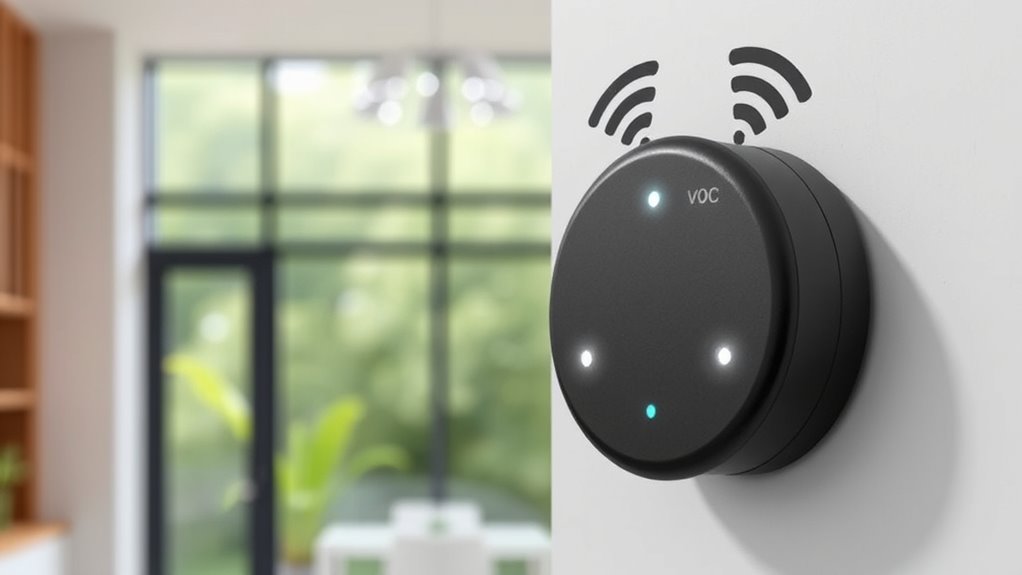
When selecting a VOC sensor with Wi‑Fi, I focus on key factors like accuracy, range, and how well it stays connected. I also consider how easily it integrates with my other smart devices and what kind of maintenance or calibration it needs. Ultimately, I look at how accessible the data is and whether it offers real-time alerts for better air quality management.
Sensor Accuracy and Range
Choosing a VOC sensor with Wi-Fi connectivity requires careful attention to its accuracy and measurement range. You want a sensor that can detect VOC levels from just a few parts per billion (ppb) up to several thousand ppm, covering typical indoor environments. High measurement accuracy, within ±10% of the actual concentration, guarantees you’re getting reliable data. Look for sensors with auto-calibration features or manual calibration options to keep measurements precise over time. It’s also essential that the sensor detects specific VOCs relevant to your needs, such as formaldehyde or benzene. Additionally, consider the sensor’s resolution and response time to ensure it can quickly and accurately detect rapid changes in VOC levels, providing real-time insights into your indoor air quality.
Connectivity Stability and Speed
Ensuring stable Wi-Fi connectivity is essential for reliable data transmission from VOC sensors with Wi-Fi features. Without it, data can be lost or delayed, compromising real-time monitoring. A good sensor should support dual-band networks (2.4 GHz and 5 GHz), which helps improve connection reliability and speed. High-speed Wi-Fi reduces latency, providing quicker updates and more accurate VOC readings. However, signal interference from other devices or thick walls can weaken the connection, affecting sensor performance and data accuracy. Regular firmware updates for the Wi-Fi module are also important, as they can enhance stability, fix bugs, and optimize transmission speeds. Prioritizing these factors guarantees your sensor stays connected, providing consistent and timely air quality information.
Integration With Smart Devices
To effectively integrate a VOC sensor with your existing smart home setup, it’s important to verify that it supports popular platforms like Alexa, Google Home, or Tuya, enabling seamless automation. Compatibility with these platforms guarantees you can control the sensor easily and incorporate it into your routines. Additionally, check if the sensor offers open APIs or supports protocols like MQTT or IFTTT, allowing for customizable automation routines tailored to your needs. Confirm that the Wi-Fi module reliably operates on 2.4 GHz networks, which are standard in most households. Also, consider whether the sensor can connect with other smart devices via cloud services, enabling remote management and multi-device scene creation. These factors ensure smooth integration and enhance your overall smart home experience.
Calibration and Maintenance Needs
Regular calibration and maintenance are essential for keeping a Wi-Fi-enabled VOC sensor accurate and reliable over time. Sensors can drift due to environmental factors, so periodic calibration—manual or automatic—is vital. Many sensors include auto-calibration features that adjust baseline measurements based on ambient conditions, reducing maintenance efforts. Regular cleaning or replacing filters is necessary to prevent false readings caused by dust or debris buildup. For battery-powered models, timely recharging or replacement ensures consistent detection and connectivity. Proper placement also plays a role; sensors should be kept in stable environments away from direct sunlight, humidity, or chemicals to preserve their accuracy and lifespan. Staying on top of calibration and maintenance routines guarantees your sensor provides precise, trustworthy air quality data.
Data Accessibility and Alerts
When selecting a VOC sensor with Wi-Fi connectivity, it’s vital to verify that it offers reliable real-time data access and effective alert features. I look for sensors that let me monitor VOC levels remotely through dedicated apps or web portals, making sure I stay informed anywhere. Alert features like push notifications or email alerts are indispensable, so I’m immediately notified if VOC levels surpass safe thresholds. Customizable alert settings allow me to tailor notifications based on specific concentration limits, providing flexibility. Data logging capabilities are also important; I want to review historical data and export records to track fluctuations over time. In the end, I verify the Wi-Fi connection is stable and compatible with my network to prevent interruptions, keeping my indoor air quality monitoring consistent and reliable.
Frequently Asked Questions
How Accurate Are Wi-Fi VOC Sensors Compared to Professional Testing?
You’re wondering how accurate Wi-Fi VOC sensors are compared to professional testing. I’ve found that while these sensors provide quick, real-time data and are great for ongoing monitoring, they typically aren’t as precise as lab analysis or professional testing methods. For critical health or legal concerns, I recommend professional testing. But for everyday use and maintaining good indoor air quality, Wi-Fi VOC sensors offer a reliable and convenient overview.
Can Wi-Fi VOC Sensors Detect Multiple Harmful Gases Simultaneously?
Imagine a sensor as a vigilant guardian, sensing multiple dangers at once. Wi-Fi VOC sensors can detect several harmful gases simultaneously, like VOCs, formaldehyde, and benzene, providing a thorough air quality snapshot. They use advanced technology to identify various compounds, giving you real-time alerts. While not as precise as professional tests, these sensors are invaluable for continuous, proactive indoor air monitoring, helping you breathe easier every day.
What Is the Typical Battery Life for Battery-Powered Wi-Fi VOC Sensors?
You’re wondering about the battery life for battery-powered Wi-Fi VOC sensors. I’ve found that it typically ranges from a few days up to several months, depending on the model, sensor activity, and power-saving features. For instance, some sensors last around 3-6 months on a single charge if they’re set to low-power mode. It’s essential to check each device’s specifications for accurate battery life expectations.
How Secure Is Data Transmission Between the Sensor and Your Mobile App?
Did you know that over 80% of IoT devices face security threats? When it comes to data transmission between a VOC sensor and my mobile app, I find it quite secure. Most sensors use encryption protocols like WPA2 or TLS to protect data. I still stay cautious by keeping firmware updated and using strong, unique passwords. Overall, these measures give me confidence in my indoor air quality monitoring system.
Are Wi-Fi VOC Sensors Compatible With All Smart Home Platforms?
You’re wondering if Wi-Fi VOC sensors work with all smart home platforms. I’ve found that compatibility varies; some sensors are designed to work seamlessly with popular platforms like Alexa, Google Home, or Apple HomeKit, while others may require additional hubs or integrations. Before purchasing, I always check the product specs to make sure it’ll fit into my existing smart home ecosystem without hassle.
Conclusion
Choosing the right VOC sensor with Wi-Fi connectivity is like finding a trusted friend who keeps your air clean. With so many options, you can easily find one that fits your needs and budget. Whether you want a simple monitor or a feature-rich device, there’s a perfect match out there. Remember, staying on top of your indoor air quality is key—think of it as giving your home a gust of fresh, healthy air every day.
